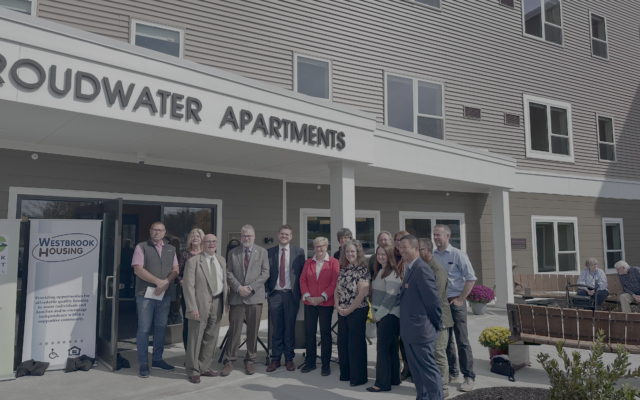This article was written by Anne Galloway and originally published at: https://vtdigger.org/2020/07/30/housing-vermont-merges-with-new-england-group/
Housing Vermont is merging with a regional nonprofit group in order to expand access to capital for low-income housing, weatherization and economic development projects in rural areas across Vermont, New Hampshire and Maine.
Northern New England Housing Investment Fund, based in Portland, Maine, and Housing Vermont, headquartered in Burlington, will form a new entity, Evernorth, the organizations announced on Thursday.
The two organizations will combine assets, maintain offices in the two states and retain an existing staff of 43 people at both locations. Evernorth will continue to provide financing expertise for local nonprofit housing groups in the three states.
Housing Vermont chief Nancy Owens will serve as co-president of Evernorth with her colleague in Maine, Bill Shanahan.
“Together, we can raise more capital that means we can build more homes and we can invest in more businesses,” Owens said.
The two nonprofits tested the idea last year with a three state investment fund last year that raised $64.5 million — nearly double what Housing Vermont and Northern New England Housing Investment Fund were able to raise separately. The increased investment will result in the construction of 514 homes — “230 more homes than we were doing previously.” With the joint fund, Evernorth is investing in 15 properties — six more than would have been possible when the two entities operated singly.
Previously, Housing Vermont raised $14.1 million and invested in four properties and 132 units. The Northern New England Housing Investment Fund, meanwhile, raised $20.8 million, built 152 units and invested in five properties, according to information from Housing Vermont.
In this round, about 44% of the joint low-income tax credit fund will be invested in Vermont this year, according to Housing Vermont officials, or roughly $28.4 million.
“We are going to exponentially grow our impact, much more than we could independently,” she said.
Owens says the merger made sense, both because of the need to attract out-of-state banks and large equity investors for capitalization, and because of common issues the three states face with respect to an aging population and tourism based economies. Northern New England also features very rural areas that struggle with poverty and old housing stock.
“We have this strong mix of very rural parts of our states and these urban centers which in Maine and New Hampshire maybe are slightly larger than they are in Vermont,” Owens said. The contrast between Burlington and, say, Caledonia County, aren’t so different from the differences between Portland and inland Maine counties.
“We have very similar kinds of issues and concerns around transportation, broadband, economic development,” Owens said.
Over the past 30 years, the two organizations have separately invested $1 billion across the three states and have created more than 13,000 homes.
The plan to combine the two organizations has been in the works for two and half years.
Housing Vermont was founded in 1988 and has made key investments in new and distressed properties that have been converted into low-income housing and economic development projects across the state.
Gus Seelig, the director of the Vermont Housing and Conservation Board, a state entity that funds projects with Housing Vermont, said the merger will enable the nonprofit to “continue delivering projects in rural communities” across the region. VHCB works on three to four deals a year on average with Housing Vermont.
“They saw a real need to bring investments to rural communities,” Seelig said. “That’s why they’re doing this.”
Seelig says he has faith in the board and leadership of both organizations. Housing Vermont in particular, he said, has “a great track record in Vermont in taking on high risk projects and doing really difficult deals and bringing expertise to communities.”
Housing Vermont has provided expertise for housing groups like Downstreet Housing in Montpelier, Champlain Housing Trust in Burlington and nonprofits in communities across the state. The community groups take the lead on identifying the most important projects and then rely on Housing Vermont to put together the financing deals and manage the construction projects.
Eileen Peltier, executive director of Downstreet, says Housing Vermont has given the Montpelier nonprofit the capacity and access to capital through low income tax credits that wouldn’t otherwise be available for small projects.
“I’m thrilled about this merger,” Peltier said. “It makes perfect sense after the practice run in 2019 when they doubled what they were able to do alone. That speaks to the value of it
“All around it’s a great thing, they’ll be stronger together,” she said. “From my perspective, it seems like a very rational thought process. It’s a win for Downstreet and the communities that we serve.”
Seelig gives Housing Vermont credit for cornerstone community projects, including a new facility for the Brattleboro Food Coop, the Transit Center in Montpelier and the renovation of Depot Square in St. Johnsbury.
In addition, Seelig says the group turned around one of the “worst slums in the state” in Windsor.
“What they’re great at is letting local people tell them, this is what our priority is,” Seelig said.
The Northern New England Housing Investment Fund “has a similar track record,” Seelig said. Erik Hoestra, development manager at Redstone Commercial Group, says the merger will give the Housing Vermont group “a more regional view of what’s happening in affordable housing.” Redstone has been involved in several projects with Housing Vermont, including the Champlain Housing Trust block on King Street and the Transit Center in Montpelier.
“It’ll lead to greater efficiency in having a larger organization in a larger area,” Hoekstra said. “One of the challenges in Vermont is we’re a very, very small state, and sometimes we aren’t as efficient as we could be because we’re so small. Looking at the whole region makes the whole thing more efficient and able to deliver more results for the state and the whole region as well.”
With a larger organization, Hoekstra says, there is an opportunity to leverage insights from all three states that could benefit the whole region. He also said there may be some efficiencies of scale that translate over time into combined executive positions and reduced administrative costs.
The primary business of Evernorth is tax credit syndication, which is the main resource for developing affordable rental housing, he said. With a larger organization, that too, could broaden the reach of Housing Vermont and the Northern New England Housing Investment Fund.
“If you have a larger organization with broader reach and greater volume of tax credit syndication, you have more negotiating power with investors buying into it that bring more resources to everything you do,” Hoekstra said.
Much of the funding for affordable housing in Vermont is already defined by a limited amount of available federal tax credits and funding through VHCB. A lot of the funding is already state based and “it can’t go to New Hampshire and Maine. “There are no resources flowing out of Vermont, really,” Hoekstra said.
“Overall, I think it’s going to be a positive thing,” he said. “I can’t see a downside to it. There’s nothing about it that decreases the resources available for Vermont.”




